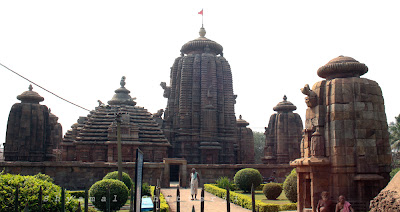TEMPLES EXTRA-ORDINARY - OUR TRIP TO TEMPLES OF ORISSA - VI.
View of Brahmeswar Temple Complex - to observe similarity of Jagmohan-Deul here with that of Lingaraja Temple.
Zodiac signs in 'pabhaga' section of Brahmeswar Temple.
Laced with female figures meant for attracting viewers' notice !
Brahmeswar temple is somewhat away from the core area of temple sites of Bhubaneswar, often missed out by tourists who are pressed for time. A tidy courtyard , Jagmohan and Deul at its centre, four smaller temples in four corners of the courtyard and a green patch at the entrance - maintained by ASI. Here are another two small temples along the pathway to the courtyard.
A section of the temple wall. Abstract design,erotica,people -
positioned one above the other as well as side-by-side,
in a very aesthetic manner.
Those who have visited Mukteswar Temple of Bhubaneswar are familiar
with its famous 'Bho'. Shall we call the wall-relief below the 'Bho' for
this temple ? Before you decide . please look at the photo above - this
wall-relief is certainly not at the centre of the wall ! Was it moved
from its designated place at some point during renovation ? Or a
deliberate positioning as an omen or just for attracting notice ?
A 'Bho'-like display. Human figures,arabesque,snakes,bells
- it has all the intriguing ingredients !
This temple was built by Kolavati Devi, mother of King Udyotkeshari. Probably around 1050 AD. The architecture has similarity with the gem of Bhubaneshswar - Lingaraja temple. Some of the wall-reliefs are exquisite. I noted a few which appeared to be precursor of a good nos of wall-reliefs we find in Surya temple, Konark - specially those of royalty, seers and erotica.
Royalty and seers. In court and private chambers.
We shall see more of them in Surya Temple,Konark.
Amid the usual wall-reliefs of deities and erotica, what attracted my notice are : abstract designs, zodiac signs, a series of unfolding love scenes and on closer scrutiny, swans and flowers. I have mentioned in one of my earlier posts about a wall-relief of 'Veenadhara Siva' (*1) - this is not so common in Orissan temples. I shall also mention a wall-relief of 'Ekapada Siva' - another special manifestation of Siva , not commonly known and a Gajalakshmi with a special attribute.
'Ekapada' Siva with all his attributes, straddling 'Apasmara'
who is also pierced by Siva's trident.
Gajalakshmi in lalitasana, holding two large full-bloomed lotuses.
Was the sculptor influenced by Surya's iconography?
The designs around are interesting too !
Her music, his desire !
Watch the man's body language & gestures by hands.
Indian sculptors have pictured 'Kama' on the walls of Hindu temples - photographers have published thousands of photos of erotica on Hindu temples.Ruby and I have collected many such photos over the years , some which can be subjects of serious viewing and discussion. Brahmeswar Temple Complex has at least 3 series - is not that an uncommon practice , one of which is presented here.
Row of swans and an elephant used for adornment of space
above a ledge.
Writers have mentioned several specialties of this temple , like the pavilion -'chandratapa' - within Jagmohan, use of Iron beams in a Bhubaneswar temple for the 1st time, adornment with birds and animals etc. To me, the wall-reliefs of Royalty/seers and string of erotica scenes - proliferation of which happened during the Konark years are important for studies.
NOTE :
*1 - Please view - http://przmm.blogspot.in/2012/06/look-alikes-in-architecture.html































